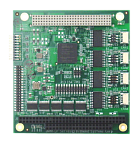 JANUS-MM-4LP-XT
PC/104-Plus Quad Isolated CAN Module with 24 Digital I/O
High Performance CAN Functionality
The Janus-MM-4LP-XT I/O module offers two or four CANbus 2.0B ports with opto-isolation plus 24 digital I/O lines. Models are available in both the PC/104-Plus and PC/104 form factors. An FGPA core houses the CAN controller logic and provides data rates up to 1Mbps. Each port supports standard and extended frames as well as expanded TX and RX message queues for enhanced performance. Each port has its own combination isolator and transceiver chip. The Janus-MM-4LP-XT fits a wide variety of rugged and on-vehicle embedded serial I/O application needs.
Digital I/O
Janus-MM-4LP-XT offers 24 programmable digital I/O lines organized as three 8-bit digital I/O ports.
Rugged Design
Janus-MM-4LP-XT was designed with harsh applications in mind including latching connectors to further improve reliability. Extended temperature operation of −40°C to +85°C is tested and guaranteed. The module is compatible with MIL-STD-202G shock and vibration specifications.
Key Features
All four CAN ports on the Janus-MM-4LP-XT are driven from an FPGA-based CAN 2.0 bus controller core which provides full CAN2.0B functionality. Each port has an Analog Devices combination isolation and transceiver chip, independently isolating it from the host system and other ports to eliminate sensitivity to noise and ground shifts in the network.
The product has several jumper configurable options including CAN termination and bias. The digital I/O logic level and pull-up / pull-down resistors are also jumper configurable.
For additional ruggedization, zero ohm jumper-bypass resistors can be installed in any configuration.
Software Support
Janus-MM-4LP-XT comes with a basic CAN driver for Windows 7, XP and Linux 2.6. The driver supports dual-independent and dual-redundant modes.
JANUS-MM-4LP-XT
PC/104-Plus Quad Isolated CAN Module with 24 Digital I/O
High Performance CAN Functionality
The Janus-MM-4LP-XT I/O module offers two or four CANbus 2.0B ports with opto-isolation plus 24 digital I/O lines. Models are available in both the PC/104-Plus and PC/104 form factors. An FGPA core houses the CAN controller logic and provides data rates up to 1Mbps. Each port supports standard and extended frames as well as expanded TX and RX message queues for enhanced performance. Each port has its own combination isolator and transceiver chip. The Janus-MM-4LP-XT fits a wide variety of rugged and on-vehicle embedded serial I/O application needs.
Digital I/O
Janus-MM-4LP-XT offers 24 programmable digital I/O lines organized as three 8-bit digital I/O ports.
Rugged Design
Janus-MM-4LP-XT was designed with harsh applications in mind including latching connectors to further improve reliability. Extended temperature operation of −40°C to +85°C is tested and guaranteed. The module is compatible with MIL-STD-202G shock and vibration specifications.
Key Features
All four CAN ports on the Janus-MM-4LP-XT are driven from an FPGA-based CAN 2.0 bus controller core which provides full CAN2.0B functionality. Each port has an Analog Devices combination isolation and transceiver chip, independently isolating it from the host system and other ports to eliminate sensitivity to noise and ground shifts in the network.
The product has several jumper configurable options including CAN termination and bias. The digital I/O logic level and pull-up / pull-down resistors are also jumper configurable.
For additional ruggedization, zero ohm jumper-bypass resistors can be installed in any configuration.
Software Support
Janus-MM-4LP-XT comes with a basic CAN driver for Windows 7, XP and Linux 2.6. The driver supports dual-independent and dual-redundant modes.
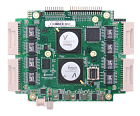 Epsilon-24000
Managed 26-Port Gigabit Ethernet Switch
Epsilon-24000 is a managed Layer 2+ Ethernet switch module offering up to 24 10/100/1000Mbps copper twisted pair ports and 2 small form factor pluggable (SFP) sockets in the compact PC/104 form factor. Epsilon-24000 is designed for rugged applications including industrial, on-vehicle and military.
Epsilon-24000 is a standalone switch that does not require any host computer interface. All switch functions are managed by a microprocessor embedded directly into the switch. The processor is accessed via an in-band web interface over one of the Ethernet ports or via an out-of-band command-line interface over an RS-232 serial port. The integrated web interface provides an intuitive GUI for use in configuring and managing all switch functionality. On-board memory holds dual application images, boot code, MAC addresses, and other parameters, and can also be used for program execution.
Epsilon-24000 includes a dual SFP socket for interfacing to 1G fiber Ethernet networks. One port can operate at enhanced 2.5G speed to support efficient stacking of two switches together for a combined total of 50 ports.
Epsilon-24000’s advanced Ethernet switch board includes two innovative features that enable automatic power savings. The switch can detect unused Ethernet ports on network devices and power them down or place them in stand-by mode. Additionally, the switch actively adjusts the power level needed based on cable length, saving energy on links shorter than the 100m maximum specified length.
Input power is provided through the built-in, wide-range +5 to +34VDC power supply, enabling operation using industrial power sources.
Epsilon-24000 was designed for use in vehicle and harsh environment applications. All I/O connectors are latching, providing enhanced reliability over the RJ-45 connectors used in commercial Ethernet switches. A 50% thicker PCB provides better protection against vibration in vehicle environments. The wide range 5-34V input power supply is compatible with all common vehicle and industrial power sources. The −40?C to +85?C operating range makes Epsilon-24000 suitable for use in outdoor and vehicle applications.
Epsilon-24000 comes loaded with all required firmware, enabling its immediate operation without any development effort. The included web interface provides an intuitive GUI for use in configuring and managing switch functionality.
Block Diagram
Epsilon-24000 Block Diagram
Development Kit
Two Development Kits are available for the Epsilon-24000. The DK-EPS-24026 Development Kit contains an EPS-24026-104 26-port Gigabit Ethernet switch, cable kit and LED accessory board. The DK-EPS-24016 Development Kit contains an EPS-24016-104 16-port Gigabit Ethernet switch, cable kit and LED accessory board.
Cable Kit
Two Epsilon-24000 cable kits are available, one for each Epsilon-24000 model. Each kit includes the necessary cables for Epsilon-24000’s inputs and outputs.
Epsilon-24000 Cable Kit
Number
Qty
Cable
Description
1
1
6981050
Serial cable
2
4 or 6, kit dependent
6981508
Quad port Ethernet cable
3
1
6981507
Power cable
Epsilon-24000
Managed 26-Port Gigabit Ethernet Switch
Epsilon-24000 is a managed Layer 2+ Ethernet switch module offering up to 24 10/100/1000Mbps copper twisted pair ports and 2 small form factor pluggable (SFP) sockets in the compact PC/104 form factor. Epsilon-24000 is designed for rugged applications including industrial, on-vehicle and military.
Epsilon-24000 is a standalone switch that does not require any host computer interface. All switch functions are managed by a microprocessor embedded directly into the switch. The processor is accessed via an in-band web interface over one of the Ethernet ports or via an out-of-band command-line interface over an RS-232 serial port. The integrated web interface provides an intuitive GUI for use in configuring and managing all switch functionality. On-board memory holds dual application images, boot code, MAC addresses, and other parameters, and can also be used for program execution.
Epsilon-24000 includes a dual SFP socket for interfacing to 1G fiber Ethernet networks. One port can operate at enhanced 2.5G speed to support efficient stacking of two switches together for a combined total of 50 ports.
Epsilon-24000’s advanced Ethernet switch board includes two innovative features that enable automatic power savings. The switch can detect unused Ethernet ports on network devices and power them down or place them in stand-by mode. Additionally, the switch actively adjusts the power level needed based on cable length, saving energy on links shorter than the 100m maximum specified length.
Input power is provided through the built-in, wide-range +5 to +34VDC power supply, enabling operation using industrial power sources.
Epsilon-24000 was designed for use in vehicle and harsh environment applications. All I/O connectors are latching, providing enhanced reliability over the RJ-45 connectors used in commercial Ethernet switches. A 50% thicker PCB provides better protection against vibration in vehicle environments. The wide range 5-34V input power supply is compatible with all common vehicle and industrial power sources. The −40?C to +85?C operating range makes Epsilon-24000 suitable for use in outdoor and vehicle applications.
Epsilon-24000 comes loaded with all required firmware, enabling its immediate operation without any development effort. The included web interface provides an intuitive GUI for use in configuring and managing switch functionality.
Block Diagram
Epsilon-24000 Block Diagram
Development Kit
Two Development Kits are available for the Epsilon-24000. The DK-EPS-24026 Development Kit contains an EPS-24026-104 26-port Gigabit Ethernet switch, cable kit and LED accessory board. The DK-EPS-24016 Development Kit contains an EPS-24016-104 16-port Gigabit Ethernet switch, cable kit and LED accessory board.
Cable Kit
Two Epsilon-24000 cable kits are available, one for each Epsilon-24000 model. Each kit includes the necessary cables for Epsilon-24000’s inputs and outputs.
Epsilon-24000 Cable Kit
Number
Qty
Cable
Description
1
1
6981050
Serial cable
2
4 or 6, kit dependent
6981508
Quad port Ethernet cable
3
1
6981507
Power cable
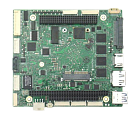 Aries SBC
PC/104-Plus SBC with Intel E3800 CPU, On-Board Data Acquisition & PCIe MiniCard I/O Expansion
Aries is a compact, rugged, single board computer that features the Intel E3800 Bay Trail processor to deliver an unmatched combination of performance, price and power consumption. Packed with real-world features, Aries provides a complete solution for most embedded applications in a single board, saving space, time, and money. Aries goes beyond the standard processor and I/O features found on other Bay Trail SBCs to provide rugged performance along with a professional-quality data acquisition circuit supported by industry-leading software. The full rectangular shape provides more coastline for I/O connectors than other boards its size. In this compact form factor, Aries includes a wide range of I/O plus data acquisition functionality, meeting the majority of today’s connectivity requirements in a single board.
Choice of CPUs
1.91GHz Intel quad core E3845 CPU
1.46GHz Intel dual core E3826 CPU
The family of Aries SBCs combine excellent CPU performance, a wide range of PC I/O, and integrated high quality data acquisition circuitry into the compact PC/104-Plus form factor at a competitive price.
Available PC I/O includes USB 2.0/3.0, RS-232/422/485, dual Gigabit Ethernet, SATA ports. The data acquisition circuit includes 16 16-bit analog inputs, 4 16-bit analog outputs, 22 digital I/O lines, pulse width modulators, and counter/timers.
Aries supports stackable I/O expansion with PC/104-Plus (ISA + PCI) I/O modules. Aries also provides a dual-use PCIe MiniCard / mSATA socket for additional I/O expansion. I/O modules featuring WiFi, Ethernet, analog I/O, digital I/O, and CAN are available in the PCIe MiniCard form factor, providing compact expandability without increasing the total height of the system.
The Aries SBC was designed with rugged applications in mind. With an operating temperature of −40°C to +85°C, soldered on-board memory, integrated heat spreader for efficient cooling, 50% thicker PCB for increased rigidity and long term reliability, and full suite of latching connectors, Aries is the perfect choice for vehicle and other harsh environment applications.
Software Support
Aries SBCs run Linux, Windows Embedded Standard 7, and Windows Embedded CE. Both Linux and Windows Embedded 7 Software Development Kits are available with bootable images and drivers to get you started on your design project right out of the box.
Data Acquisition
The Aries SBCs include a complete analog and digital data acquisition circuit integrated onto the board. The analog section includes 16 16-bit analog input channels and a 2048-sample FIFO with programmable input ranges and a maximum sampling rate of 250KHz. There are 4 16-bit analog outputs with programmable voltage and current output ranges. 22 programmable digital I/O lines are provided as well as 8 32-bit counter/timers, 4 24-bit pulse width modulators, and a waveform generator.
All data acquisition features are supported by Diamond’s free, best-in-class Universal Driver programming software which simplifies application development. Intuitive, easy-to-use graphical control panels make programming all of the data acquisition features fast and simple.
Block Diagram
Aries Development Kits
The Aries Development Kits provide all the components you need for fast and efficient embedded development. The kit includes the 1.91GHz Aries SBC with 4GB DRAM and integrated data acquition, cable kit (CK-ARS-01), power adapter cable, a 16GB mSATA flashdisk with Linux pre-loaded, and a software CD with Linux drivers.
A Linux software development kit (SDK-ARS-LNX) is also available. This kit contains a 16GB flashdisk with a bootable Linux image and a CD with a backup copy of the image plus Linux software development tools.
Aries Cable Kit
The Aries cable kit (CK-ARS-01T) includes cables for most of Aries’ on-board I/O. Many cables are also available individually.
Number
Qty
Cable
Description
1
2
6980500
Dual serial cable
2
1
6980501
Digital I/O cable
3
1
6980503
Dual USB cable
4
1
6980504
Analog I/O cable
5
1
6980507
Analog I/O cable
6
1
6980508
Audio cable
7
1
6980511
Battery cable
8
1
6980512
Power cable
9
2
6980513
Ethernet cable
10
1
6980514
Utility cable
Aries SBC
PC/104-Plus SBC with Intel E3800 CPU, On-Board Data Acquisition & PCIe MiniCard I/O Expansion
Aries is a compact, rugged, single board computer that features the Intel E3800 Bay Trail processor to deliver an unmatched combination of performance, price and power consumption. Packed with real-world features, Aries provides a complete solution for most embedded applications in a single board, saving space, time, and money. Aries goes beyond the standard processor and I/O features found on other Bay Trail SBCs to provide rugged performance along with a professional-quality data acquisition circuit supported by industry-leading software. The full rectangular shape provides more coastline for I/O connectors than other boards its size. In this compact form factor, Aries includes a wide range of I/O plus data acquisition functionality, meeting the majority of today’s connectivity requirements in a single board.
Choice of CPUs
1.91GHz Intel quad core E3845 CPU
1.46GHz Intel dual core E3826 CPU
The family of Aries SBCs combine excellent CPU performance, a wide range of PC I/O, and integrated high quality data acquisition circuitry into the compact PC/104-Plus form factor at a competitive price.
Available PC I/O includes USB 2.0/3.0, RS-232/422/485, dual Gigabit Ethernet, SATA ports. The data acquisition circuit includes 16 16-bit analog inputs, 4 16-bit analog outputs, 22 digital I/O lines, pulse width modulators, and counter/timers.
Aries supports stackable I/O expansion with PC/104-Plus (ISA + PCI) I/O modules. Aries also provides a dual-use PCIe MiniCard / mSATA socket for additional I/O expansion. I/O modules featuring WiFi, Ethernet, analog I/O, digital I/O, and CAN are available in the PCIe MiniCard form factor, providing compact expandability without increasing the total height of the system.
The Aries SBC was designed with rugged applications in mind. With an operating temperature of −40°C to +85°C, soldered on-board memory, integrated heat spreader for efficient cooling, 50% thicker PCB for increased rigidity and long term reliability, and full suite of latching connectors, Aries is the perfect choice for vehicle and other harsh environment applications.
Software Support
Aries SBCs run Linux, Windows Embedded Standard 7, and Windows Embedded CE. Both Linux and Windows Embedded 7 Software Development Kits are available with bootable images and drivers to get you started on your design project right out of the box.
Data Acquisition
The Aries SBCs include a complete analog and digital data acquisition circuit integrated onto the board. The analog section includes 16 16-bit analog input channels and a 2048-sample FIFO with programmable input ranges and a maximum sampling rate of 250KHz. There are 4 16-bit analog outputs with programmable voltage and current output ranges. 22 programmable digital I/O lines are provided as well as 8 32-bit counter/timers, 4 24-bit pulse width modulators, and a waveform generator.
All data acquisition features are supported by Diamond’s free, best-in-class Universal Driver programming software which simplifies application development. Intuitive, easy-to-use graphical control panels make programming all of the data acquisition features fast and simple.
Block Diagram
Aries Development Kits
The Aries Development Kits provide all the components you need for fast and efficient embedded development. The kit includes the 1.91GHz Aries SBC with 4GB DRAM and integrated data acquition, cable kit (CK-ARS-01), power adapter cable, a 16GB mSATA flashdisk with Linux pre-loaded, and a software CD with Linux drivers.
A Linux software development kit (SDK-ARS-LNX) is also available. This kit contains a 16GB flashdisk with a bootable Linux image and a CD with a backup copy of the image plus Linux software development tools.
Aries Cable Kit
The Aries cable kit (CK-ARS-01T) includes cables for most of Aries’ on-board I/O. Many cables are also available individually.
Number
Qty
Cable
Description
1
2
6980500
Dual serial cable
2
1
6980501
Digital I/O cable
3
1
6980503
Dual USB cable
4
1
6980504
Analog I/O cable
5
1
6980507
Analog I/O cable
6
1
6980508
Audio cable
7
1
6980511
Battery cable
8
1
6980512
Power cable
9
2
6980513
Ethernet cable
10
1
6980514
Utility cable
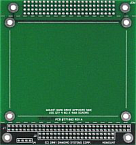 ACC-HDDMOUNT
PC/104 Hard Drive Mounting Board
ACC-HDDMOUNT provides a convenient way to mount a 2.5" notebook hard drive directly onto a PC/104 stack in either the top or bottom position. Holes on the board enable the PC/104 connectors to pass through unaffected, so the board can be installed at the bottom of the stack closer to the lower board. Mounting spacers and screws for both the hard drive and the board are included, along with a 44-pin ribbon cable.
The holes at the top of the board provide a small prototype area for customer circuitry. These are not designed to enable the installation or pass-through of a PC/104+ connector. The size of a 2.5" hard drive is too large to accommodate both the ISA and PCI connectors on a PC/104 size board.
ACC-HDDMOUNT
PC/104 Hard Drive Mounting Board
ACC-HDDMOUNT provides a convenient way to mount a 2.5" notebook hard drive directly onto a PC/104 stack in either the top or bottom position. Holes on the board enable the PC/104 connectors to pass through unaffected, so the board can be installed at the bottom of the stack closer to the lower board. Mounting spacers and screws for both the hard drive and the board are included, along with a 44-pin ribbon cable.
The holes at the top of the board provide a small prototype area for customer circuitry. These are not designed to enable the installation or pass-through of a PC/104+ connector. The size of a 2.5" hard drive is too large to accommodate both the ISA and PCI connectors on a PC/104 size board.
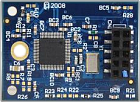 Flashdisk
Flashdisk Solid-State Storage
Install an IDE flashdisk module onto any of our CPU boards for rugged, lightweight, solid-state mass storage. The flashdisk module works just like an IDE drive and requires no drivers. It provides high-speed nonvolatile mass storage in capacities of 128MB to 4GB. The flashdisk mounts on the IDE connector and is held in place with a spacer and screws (included). It includes a master/slave jumper and operates over -40...+85ºC.
IDE Flashdisk Programming Board
ACC-IDEEXT accessory board lets you connect an IDE flashdisk and an IDE drive (hard disk or CD-ROM), or two IDE drives, to your Diamond Systems’ single board computer. You can also use it to load files from your desktop computer onto an IDE flashdisk module prior to installing the flashdisk onto the SBC. The ACC-IDEEXT board includes 40-pin and 44-pin mating connectors for compatibility with almost any computer and IDE device. 40-pin and 44-pin ribbon cables are included.
Flashdisk
Flashdisk Solid-State Storage
Install an IDE flashdisk module onto any of our CPU boards for rugged, lightweight, solid-state mass storage. The flashdisk module works just like an IDE drive and requires no drivers. It provides high-speed nonvolatile mass storage in capacities of 128MB to 4GB. The flashdisk mounts on the IDE connector and is held in place with a spacer and screws (included). It includes a master/slave jumper and operates over -40...+85ºC.
IDE Flashdisk Programming Board
ACC-IDEEXT accessory board lets you connect an IDE flashdisk and an IDE drive (hard disk or CD-ROM), or two IDE drives, to your Diamond Systems’ single board computer. You can also use it to load files from your desktop computer onto an IDE flashdisk module prior to installing the flashdisk onto the SBC. The ACC-IDEEXT board includes 40-pin and 44-pin mating connectors for compatibility with almost any computer and IDE device. 40-pin and 44-pin ribbon cables are included.
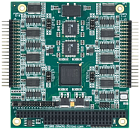 Emerald-MM-8PL
8-Channel, Software Programmable PC/104 Serial Port Module
Emerald-MM-8PL offers 8 multi-protocol serial ports on a single PC/104 module with complete software configurability via the operating system. Each port can be individually selected for RS-232, RS-422, or RS-485 under software control. Both local-echo and non-local-echo modes are supported for RS-485. I/O addresses and interrupt levels are also programmable, with interrupt sharing available for any number of ports. Each port may further be enabled or disabled in software. All configuration data is stored in an on-board EEPROM that is loaded automatically on power-up.
For applications where fixed addresses are desired, four groups of preset addresses are available with jumper settings that override the programmed settings. Line termination for RS-422/485 modes is also jumper-selectable.
Emerald-MM-8PL offers 8 convenient digital I/O lines. The direction of each line is independently programmable. Diamond’s Universal Driver software provides software support for these digital I/O lines.
Two I/O headers are provided, with four serial ports and four digital I/O lines on each header. The board operates on +5V only, eliminating the need for a +12V supply that is often required for serial port operation.
Emerald-MM-8PL is based on the industry-standard 16C654 quad serial port IC. Two ICs provide a total of 8 serial ports. Each port contains 64-byte transmit and receive FIFOs to support the high-speed 115.2kbps data rates. Drivers are available for a wide range of operating systems including Windows 10 and Linux.
Note to existing customers:
Emerald-MM-8PL is a form-fit-function replacement for our previous product Emerald-MM-8P (EMM-8P-XT) with the single exception that the maximum RS-232 data rate is limited to 115.2Kbps vs. 460.8Kbps on EMM-8P-XT. This change is due to the end of life of the RS-232 transceiver used on EMM-8P-XT. Except for this component, all other components and the PCB are the same between the two boards.
Emerald-MM-8PL
8-Channel, Software Programmable PC/104 Serial Port Module
Emerald-MM-8PL offers 8 multi-protocol serial ports on a single PC/104 module with complete software configurability via the operating system. Each port can be individually selected for RS-232, RS-422, or RS-485 under software control. Both local-echo and non-local-echo modes are supported for RS-485. I/O addresses and interrupt levels are also programmable, with interrupt sharing available for any number of ports. Each port may further be enabled or disabled in software. All configuration data is stored in an on-board EEPROM that is loaded automatically on power-up.
For applications where fixed addresses are desired, four groups of preset addresses are available with jumper settings that override the programmed settings. Line termination for RS-422/485 modes is also jumper-selectable.
Emerald-MM-8PL offers 8 convenient digital I/O lines. The direction of each line is independently programmable. Diamond’s Universal Driver software provides software support for these digital I/O lines.
Two I/O headers are provided, with four serial ports and four digital I/O lines on each header. The board operates on +5V only, eliminating the need for a +12V supply that is often required for serial port operation.
Emerald-MM-8PL is based on the industry-standard 16C654 quad serial port IC. Two ICs provide a total of 8 serial ports. Each port contains 64-byte transmit and receive FIFOs to support the high-speed 115.2kbps data rates. Drivers are available for a wide range of operating systems including Windows 10 and Linux.
Note to existing customers:
Emerald-MM-8PL is a form-fit-function replacement for our previous product Emerald-MM-8P (EMM-8P-XT) with the single exception that the maximum RS-232 data rate is limited to 115.2Kbps vs. 460.8Kbps on EMM-8P-XT. This change is due to the end of life of the RS-232 transceiver used on EMM-8P-XT. Except for this component, all other components and the PCB are the same between the two boards.
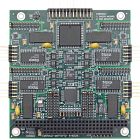 Emerald-MM-Opto
2 or 4-Port RS-232/RS-422/RS-485 PC/104 Module
Emerald-MM-Opto provides an integrated, rugged, and reliable solution for PC/104-expandable embedded systems requiring serial communications in demanding applications. It offers 2 or 4 optically isolated serial ports with RS-232, RS-422, and RS-485 protocols, as well as 24 digital I/O lines, all on a single board.
Optical isolation of 1000V DC or AC protects your embedded system from ground differentials or noise spikes that would damage non-isolated boards. Each port is isolated from the other ports as well as the system. Extended temperature capability (-40 to +85ºC) enables the board to operate in vehicles such as trains and buses without concern for temperature swings. These features enable Emerald-MM-Opto to provide reliable serial communications in harsh environments such as trains and buses.
In addition to ruggedness, Emerald-MM-Opto offers flexibility and advanced features. Each serial port is independently configurable for protocol and IRQ settings. Eight different I/O address combinations are built in. The 16C2850 UART chips with 128-byte FIFOs support high-speed data rates at up to 460kbps without overloading the system processor. Auto-flow control enables easy RS-485 operation by automatically enabling and disabling the transmitter during data transmission, to prevent bus conflicts or excessive software overhead.
Emerald-MM-Opto also offers multiple termination methods on the serial ports to support varying interface requirements. In RS-422 or RS-485 networks, termination resistors are normally installed at the endpoints of the cables to minimize reflections on the lines. The board provides jumper-selectable termination and pull-up/pull-down resistors for this purpose. The sensible jumper positioning and layout help simplify board configuration and minimize confusion.
The 24 digital I/O lines are based on an 82C55 chip and feature programmable direction in 4- and 8-bit groups. All I/O lines contain user-configurable 10K Ohm pull-up resistors for convenience. This 2-in-1 combination of serial ports and digital I/O can help lower the size and cost of your embedded system by eliminating one additional board from your PC/104 stack.
Diamond Systems offers appropriate mating cables for your convenience. Cable no. C-DB9M-1 provides a DB-9 male connector with standard PC serial port pinout. Each serial port requires one cable. Cable no. C-26-18 is a 26-conductor ribbon cable for the digital I/O lines.
Emerald-MM-Opto
2 or 4-Port RS-232/RS-422/RS-485 PC/104 Module
Emerald-MM-Opto provides an integrated, rugged, and reliable solution for PC/104-expandable embedded systems requiring serial communications in demanding applications. It offers 2 or 4 optically isolated serial ports with RS-232, RS-422, and RS-485 protocols, as well as 24 digital I/O lines, all on a single board.
Optical isolation of 1000V DC or AC protects your embedded system from ground differentials or noise spikes that would damage non-isolated boards. Each port is isolated from the other ports as well as the system. Extended temperature capability (-40 to +85ºC) enables the board to operate in vehicles such as trains and buses without concern for temperature swings. These features enable Emerald-MM-Opto to provide reliable serial communications in harsh environments such as trains and buses.
In addition to ruggedness, Emerald-MM-Opto offers flexibility and advanced features. Each serial port is independently configurable for protocol and IRQ settings. Eight different I/O address combinations are built in. The 16C2850 UART chips with 128-byte FIFOs support high-speed data rates at up to 460kbps without overloading the system processor. Auto-flow control enables easy RS-485 operation by automatically enabling and disabling the transmitter during data transmission, to prevent bus conflicts or excessive software overhead.
Emerald-MM-Opto also offers multiple termination methods on the serial ports to support varying interface requirements. In RS-422 or RS-485 networks, termination resistors are normally installed at the endpoints of the cables to minimize reflections on the lines. The board provides jumper-selectable termination and pull-up/pull-down resistors for this purpose. The sensible jumper positioning and layout help simplify board configuration and minimize confusion.
The 24 digital I/O lines are based on an 82C55 chip and feature programmable direction in 4- and 8-bit groups. All I/O lines contain user-configurable 10K Ohm pull-up resistors for convenience. This 2-in-1 combination of serial ports and digital I/O can help lower the size and cost of your embedded system by eliminating one additional board from your PC/104 stack.
Diamond Systems offers appropriate mating cables for your convenience. Cable no. C-DB9M-1 provides a DB-9 male connector with standard PC serial port pinout. Each serial port requires one cable. Cable no. C-26-18 is a 26-conductor ribbon cable for the digital I/O lines.
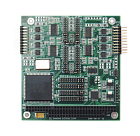 Emerald-MM-4M-XT
4-Port RS-232/RS-422/RS-485 PC/104 Module
The Emerald-MM PC/104 module gives you 4 serial ports operating at speeds up to 115kbps. In RS-232 mode, the full complement of standard PC serial port signals (8 signals + ground) are provided for each port and are grouped onto two 20-pin headers (2 ports per header). In RS-422 mode, Signals RX+, RX-, TX+, and TX- are provided, along with ground. In RS-485 mode, signals TX+/RX+ and TX-/RX- are provided, along with ground.
5V-only operation and −40°C to +85°C industrial operating temperature range are standard features. The industry-standard 16C554 UART is compatible with all popular embedded operating systems.
Flexible Configuration
Emerald-MM offers more interrupt level and I/O address options than other quad serial port modules. Therefore, integrating the board into your computer system is a simpler task. Eight different I/O address combinations and 10 different interrupt levels are available.
Interrupt Sharing
To help conserve ISA bus interrupts, any number of ports can share the same interrupt level. If you have two boards in one system, both boards can share the same interrupt level as well. An interrupt status register is provided to indicate the status of each serial port’s interrupt request signal.
Interrupt Configuration
Interrupt levels are individually selectable for each port. The available interrupt levels are 2, 3, 4, 5, 6, 7, 10, 11, 12, and 15. In addition, a 1K Ohm pulldown resistor is provided for each port.
A single interrupt level can be shared by 2, 3, or 4 ports on one board and can even be shared by more than one board in the system. To enable interrupt sharing, set two or more interrupt level jumpers to the same level and pull out all but one pulldown resistor jumper.
Emerald-MM-4M-XT
4-Port RS-232/RS-422/RS-485 PC/104 Module
The Emerald-MM PC/104 module gives you 4 serial ports operating at speeds up to 115kbps. In RS-232 mode, the full complement of standard PC serial port signals (8 signals + ground) are provided for each port and are grouped onto two 20-pin headers (2 ports per header). In RS-422 mode, Signals RX+, RX-, TX+, and TX- are provided, along with ground. In RS-485 mode, signals TX+/RX+ and TX-/RX- are provided, along with ground.
5V-only operation and −40°C to +85°C industrial operating temperature range are standard features. The industry-standard 16C554 UART is compatible with all popular embedded operating systems.
Flexible Configuration
Emerald-MM offers more interrupt level and I/O address options than other quad serial port modules. Therefore, integrating the board into your computer system is a simpler task. Eight different I/O address combinations and 10 different interrupt levels are available.
Interrupt Sharing
To help conserve ISA bus interrupts, any number of ports can share the same interrupt level. If you have two boards in one system, both boards can share the same interrupt level as well. An interrupt status register is provided to indicate the status of each serial port’s interrupt request signal.
Interrupt Configuration
Interrupt levels are individually selectable for each port. The available interrupt levels are 2, 3, 4, 5, 6, 7, 10, 11, 12, and 15. In addition, a 1K Ohm pulldown resistor is provided for each port.
A single interrupt level can be shared by 2, 3, or 4 ports on one board and can even be shared by more than one board in the system. To enable interrupt sharing, set two or more interrupt level jumpers to the same level and pull out all but one pulldown resistor jumper.
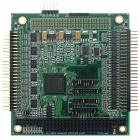 GPIO-MM
Reconfigurable 48-line Digital I/O + Counter/Timer PC/104 Module
GPIO-MM is part of a family of reconfigurable digital I/O and counter / timer modules with various port and pin configurations. Each board uses identical hardware with a 200K gate Xilinx Spartan II RAM-based FPGA. The varying configurations are based on different FPGA code. The FPGA code is stored in a flash memory on the board, enabling GPIO-MM to be reprogrammed in the field with different designs, including custom designs.
The GPIO-MM configuration provides 48 digital I/O lines and 10 programmable counter/timers. The counter/timer features are based on our legacy Quartz-MM board, while the 48 digital I/O lines are compatible with our legacy Garnet-MM board. This configuration combines the features of both these boards into one board to reduce your PC/104 stack size and cost.
Other GPIO-MM configurations provide up to 96 digital I/O lines.
GPIO-MM
Reconfigurable 48-line Digital I/O + Counter/Timer PC/104 Module
GPIO-MM is part of a family of reconfigurable digital I/O and counter / timer modules with various port and pin configurations. Each board uses identical hardware with a 200K gate Xilinx Spartan II RAM-based FPGA. The varying configurations are based on different FPGA code. The FPGA code is stored in a flash memory on the board, enabling GPIO-MM to be reprogrammed in the field with different designs, including custom designs.
The GPIO-MM configuration provides 48 digital I/O lines and 10 programmable counter/timers. The counter/timer features are based on our legacy Quartz-MM board, while the 48 digital I/O lines are compatible with our legacy Garnet-MM board. This configuration combines the features of both these boards into one board to reduce your PC/104 stack size and cost.
Other GPIO-MM configurations provide up to 96 digital I/O lines.
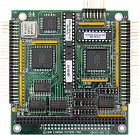 Onyx-MM
Programmable Counter/Timer, Interrupt, and Digital I/O PC/104 Module
Extensive software control of features is the highlight of this digital I/O module featuring 48 digital I/O lines, 3x 16-bit counter/timers, and 3 independent PC bus interrupt inputs.
The 48 digital I/O lines on Onyx-MM are based on 2 82C55 ICs. They can be programmed for input or output in groups of 8 lines. Direct as well as strobed (latched) I/O modes are supported, and all I/O lines are connected to 10K Ohm pull-up resistors.
The 3 16-bit counter/timers are based on an 82C54 IC. They are controlled through a configuration register on Onyx-MM (in addition to the standard 82C54 configuration register). The counter inputs can be switched between external signals, the on-board 4MHz clock oscillator, or counter outputs, all under software control. By using one counters output as another counters input, you can cascade counters in software to create a 32-bit or 48-bit counter.
Onyx-MM also features programmable interrupt operations. A second software-controlled register on board configures up to 3 interrupt lines on the PC bus. Interrupts can be generated by the counter/timer outputs, digital I/O lines, or an external input line. This allows you to use a counter to generate bus interrupts at a programmed periodic rate, generate hardware interrupts under software control, or generate interrupts in response to an external event.
Onyx-MM
Programmable Counter/Timer, Interrupt, and Digital I/O PC/104 Module
Extensive software control of features is the highlight of this digital I/O module featuring 48 digital I/O lines, 3x 16-bit counter/timers, and 3 independent PC bus interrupt inputs.
The 48 digital I/O lines on Onyx-MM are based on 2 82C55 ICs. They can be programmed for input or output in groups of 8 lines. Direct as well as strobed (latched) I/O modes are supported, and all I/O lines are connected to 10K Ohm pull-up resistors.
The 3 16-bit counter/timers are based on an 82C54 IC. They are controlled through a configuration register on Onyx-MM (in addition to the standard 82C54 configuration register). The counter inputs can be switched between external signals, the on-board 4MHz clock oscillator, or counter outputs, all under software control. By using one counters output as another counters input, you can cascade counters in software to create a 32-bit or 48-bit counter.
Onyx-MM also features programmable interrupt operations. A second software-controlled register on board configures up to 3 interrupt lines on the PC bus. Interrupts can be generated by the counter/timer outputs, digital I/O lines, or an external input line. This allows you to use a counter to generate bus interrupts at a programmed periodic rate, generate hardware interrupts under software control, or generate interrupts in response to an external event.
